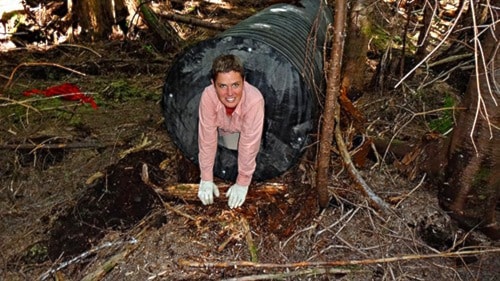A project is underway in the Jordan River watershed that is attempting to create black bear dens in existing forest structures and by using plastic culverts. The project is aimed at increasing the availability of black bear dens in the Jordan River watershed on Vancouver Island using a new and innovative approach.
Coastal black bears use large diameter (mean = 143 cm) trees or wooden structures derived from trees (logs, windfalls and stumps) for winter dens and generations of bears often re-use the same den. Black bears den three-to-six months in coastal B.C. and females give birth to cubs in their dens. Coastal black bears likely use only wooden structures in B.C. because of the cool and wet weather during the winter, unlike other parts of North America where they may dig dens in the earth or den in nests on the ground.
Current and past land management practices, including flooding of forested land for hydro-electric development and ongoing forest harvesting removes large trees from the potential den supply on Vancouver Island. The BC provincial government does not provide any regulatory protection for these structures, however, forest companies take the initiative to conserve dens during harvesting that are found during layout (i.e., preparation for harvesting).
The team, led by Helen Davis of Artemis Wildlife Consultants, “installed” three artificial black bear dens in July 2014. The dens simulate naturally-occurring den structures but are made from plastic culverts (constructed by Armtec Infrastructure in Nanaimo) closed at one end and open at the other, to allow entry by black bears.
The three-metre-long dens have been installed in locations suitable for black bears on TimberWest Forest Corps lands and a TFL operated by Pacheedaht Anderson Timber Holdings LP.
The effectiveness of this new pilot approach to creating artificial dens with plastic culverts will be monitored and assessed for effectiveness by Davis and her team. Dens are monitored by remote cameras; one camera revealed a den being investigated by a black bear three days after installation! The project is funded by the Fish and Wildlife Compensation Program – Coastal Region. The Fish and Wildlife Compensation Program (FWCP) supports conservation and enhancement in watersheds impacted by the initial construction of BC Hydro hydroelectric generation facilities.
In addition to installing artificial dens, Davis and her crew are improving available den habitat by:
This is the first year of a proposed two-year project (future FWCP funding to be confirmed) that will create black bear dens in existing forest structures, and evaluate opportunities for artificial den creation.
TimberWest was happy to support the investigation into bear den enhancement in their second growth forests. Senior Biologist Dave Lindsay, RPBio, initiated a company-wide bear den inventory in the early 1990s which has been diligently maintained and continues today. “The results of this study combined with our den inventory will help us maintain healthy black bear populations across our land base,” says Lindsay.
The Pacheedaht First Nation have been actively involved in installing and creating these dens, and is supportive of the project because black bears figure prominently in their culture and it is their hope that improving and maintaining a supply of dens will support black bear populations.
Pacheedaht Andersen Timber Holdings LP is a proud supporter of the black bear den creation project. Projects of this nature allow researchers to gather accurate data about local bears’ general living and territorial habits. This data provides excellent information for forest management planning, recreational planning and for the general well-being of bears in the area.
Submitted by Helen Davis, Artemis Wildlife Consultants
